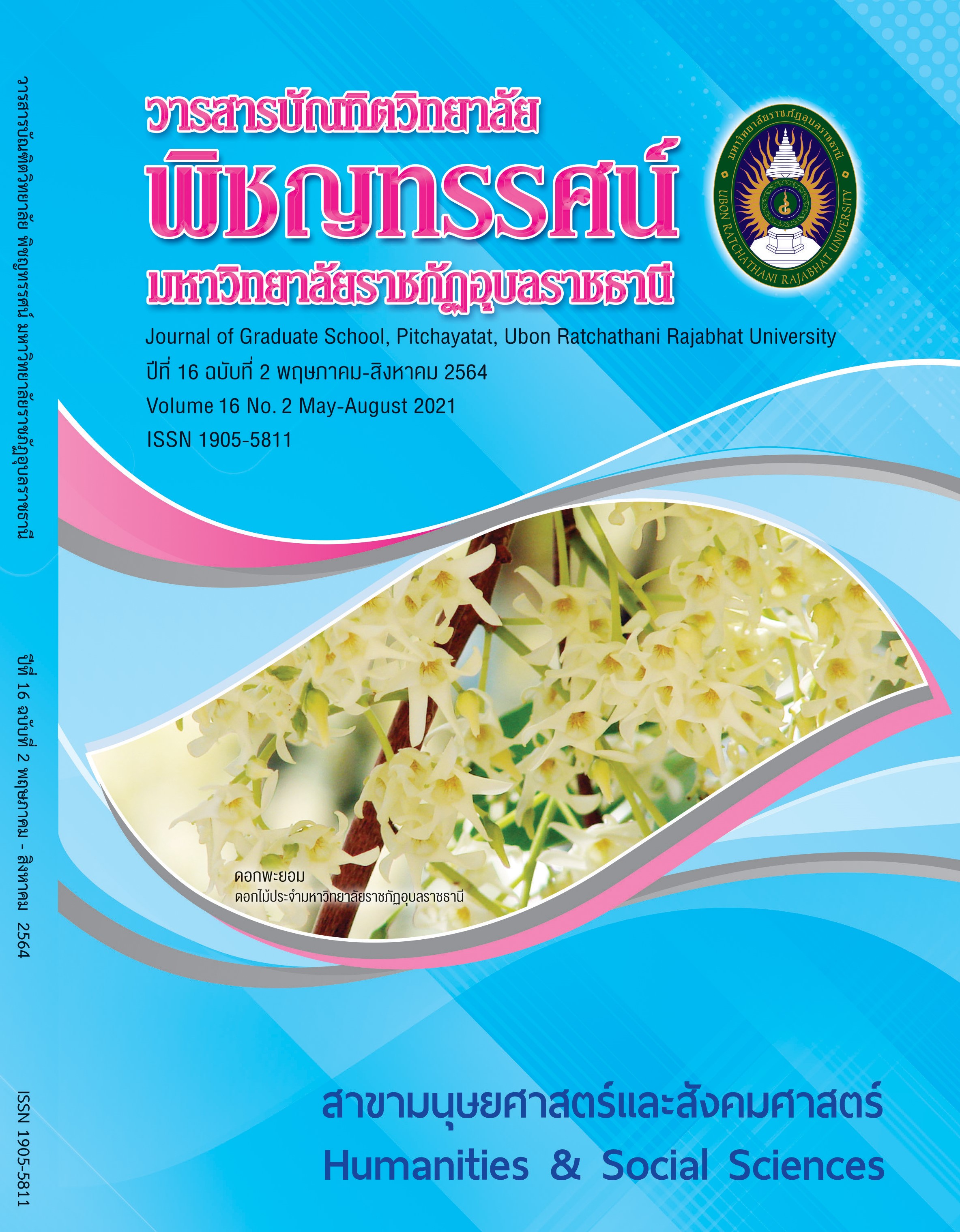การศึกษาเพื่อปวงชน : ความเสมอภาคทางการศึกษาของประชาชน
คำสำคัญ:
การศึกษาเพื่อปวงชน, ความเสมอภาคทางการศึกษาบทคัดย่อ
การศึกษาเพื่อปวงชนเป็นแนวคิดในการพัฒนาทรัพยากรมนุษย์ที่ครอบคลุมกับมนุษย์ ทุกเพศ ทุกวัยทุกฐานะ ทุกศาสนา ทุกเชื้อชาติ และทุกถิ่นที่อยู่อาศัย ให้ได้รับโอกาสทางการศึกษาอย่างทั่วถึงโดยไม่มีการเลือกปฏิบัติ ซึ่งการศึกษานั้นจะต้องเป็นการศึกษาที่เหมาะสมกับบริบทของมนุษย์แต่ละคน เพื่อให้มีความรู้และทักษะที่จะสามารถนำไปใช้ในการดำรงชีวิตได้อย่างมีคุณภาพ เนื่องจากการศึกษานั้นจะนำมาซึ่งคุณภาพของคนและคุณภาพของประเทศ ดังนั้นบทความเรื่องการศึกษาเพื่อปวงชน : ความเสมอภาคทางการศึกษาของประชาชน จึงมีเป้าหมายเพื่อนำเสนอความเป็นมาและเป้าประสงค์ของการศึกษาเพื่อปวงชน ตัวอย่างการจัดการศึกษาเพื่อปวงชนในต่างประเทศ สภาพการณ์การศึกษาไทย ที่เมื่อผู้เขียนได้วิเคราะห์แล้วพบว่าสถานการณ์การศึกษาของไทยในปัจจุบันนี้มีการเพิ่มขึ้นของร้อยละในการเข้าถึงการศึกษาของประชาชนก็ตาม แต่การเข้าถึงการศึกษานั้นก็ยังแฝงไว้ด้วยความเหลื่อมทางการศึกษา ดังเช่นตัวอย่างความเหลื่อมล้ำทางการศึกษาที่ผู้เขียนได้นำเสนอไว้ในบทความ และเมื่อมีความเหลื่อมล้ำทางการศึกษาเกิดขึ้นจึงทำให้ภาครัฐได้กำหนดนโยบายทางการศึกษาที่ช่วยลดเหลื่อมล้ำและสร้างความเสมอภาคทางการศึกษาให้แก่ประชนคนไทย แต่ประเทศไทยนั้นก็มิได้มีเพียงแค่ประชาชนคนไทยเท่านั้น ที่มีความจำเป็นที่จะต้องเข้าถึงการศึกษา บุคคลข้ามชาติ เช่น แรงงานต่างด้าว หรือบุคคลไร้รัฐไร้สัญชาติ ก็มีความจำเป็นในการเข้าถึงการศึกษาเช่นกัน ภาคเอกชนจึงได้เข้ามามีส่วนร่วมในการสร้างความเท่าเทียมและเสมอภาคทางการศึกษาให้แก่บุคคลเหล่านี้ ซึ่งแนวทางที่ใช้ในการจัดการศึกษาเพื่อปวงชนให้แก่ประชาชนทุกคนนั้น ควรมีลักษณะดังเช่นที่ผู้เขียนได้นำเสนอไว้ คือ ควรจัดการศึกษา ตามหลักสิทธิมนุษยชนที่สามารถทำให้กลุ่มคนทุกชนชั้นมีความเท่าเทียมกันในสังคม โดยรัฐต้องกำหนดนโยบายการศึกษาเพื่อปวงชนที่สร้างความตระหนักและสนับสนุนให้ประชาชนทุกคนในประเทศสามารถเข้าถึงการศึกษาได้ อีกทั้งควรมีการพัฒนาระบบการจัดการศึกษาในระดับจังหวัดทุกจังหวัดให้มีคุณภาพใกล้เคียงกันทั้งประเทศ รวมไปถึงการพัฒนาหลักสูตรการจัดการศึกษาเพื่อปวงชนที่สามารถตอบสนองความต้องที่หลากหลายของผู้เรียนและสอดคล้องกับบริบทการพัฒนาประเทศไทย แต่ทั้งนี้ทั้งนั้นรัฐจะต้องมีการติดตามผลการดำเนินงานของผู้ที่มีส่วนเกี่ยวข้องอย่างจริงจังเพื่อประโยชน์ทางการศึกษาของประชาชน
เอกสารอ้างอิง
กฤตยากร ลดาวัลย์. “การจัดการศึกษาท้องถิ่นสู่การพัฒนาอย่างยั่งยืน,” วิชาการธรรมทรรศน์, 20, 4 (ตุลาคม-ธันวาคม 2563): 209-216.
กองทุนเพื่อความเสมอภาคทางการศึกษา. พระราชบัญญัติกองทุนเพื่อความเสมอภาคทางการศึกษา.พ.ศ.2561. (ออนไลน์) 2561 (อ้างเมื่อ 12 กุมภาพันธ์ 2564). จาก http://www.ratchakitcha.soc.go.th/DATA/PDF/2561/ N033/1.PDF
เกรียงศักดิ์ เจริญวงศักดิ์. มหาวิทยาลัยที่ทางแยก. กรุงเทพฯ: ส.เอเชีย เพรส, 2541.
คณะกรรมการการศึกษาขั้นพื้นฐาน. พระราชบัญญัติการศึกษาแห่งชาติ พ.ศ. 2542 แก้ไขเพิ่มเติม (ฉบับที่ 2) พ.ศ. 2545 และ (ฉบับที่ 3) พ.ศ. 2553. กรุงเทพฯ: สำนักงานฯ, 2553.
คณะกรรมการพัฒนาเศรษฐกิจและสังคมแห่งชาติ, สำนักงาน. คู่มือเทคนิคการปรับปรุงและพัฒนาองค์การเวอร์ชั่น 1.0. กรุงเทพฯ: อมรินทร์พริ้นแอนด์พับลิชชิ่ง, 2560.
คณะกรรมการพัฒนาเศรษฐกิจและสังคมแห่งชาติ, สำนักงาน. แผนพัฒนาเศรษฐกิจและสังคมแห่งชาติ ฉบับที่ 12 (พ.ศ.2560-2564). กรุงเทพฯ: อมรินทร์พริ้นติ้งแอนด์พับลิชชิ่ง, 2560.
รายงานประจำปี 2562. (ออนไลน์) 2562 (อ้างเมื่อ 4 กรกฏคม 2564). จาก https://www.eef.or.th/wp-content/uploads/2020/06/O12-EEF-Annual-Report-2019.pdf
จรัส สุวรรณเวลา. อุดมศึกษาไทย. กรุงเทพฯ: จุฬาลงกรณ์มหาวิทยาลัย, 2545.
เจษฎา ศาลาทอง. สื่อกับการศึกษาเพื่อการพัฒนาอย่างยั่งยืน. (ออนไลน์) 2560 (อ้างเมื่อ 12 กุมภาพันธ์ 2564).
จาก https://jesssalathong.wixsite.com/salathong/untitled-c1s3q
ชรินทร์ มั่งคั่ง. “รูปแบบหลักสูตรเพื่อปวงชนขององค์กรประชาสังคมสำหรับนักเรียนชาติพันธุ์ในจังหวัดเชียงใหม่,”ศึกษาศาสตร์ มหาวิทยาลัยทักษิณ. 18, 1(มกราคม-มิถุนายน 2561): 210-222.
ณปภัช บรรณาการ และสิวะโชติ ศรีสุทธิยากร. “ความเหลื่อมล้ำทางการศึกษาของนักเรียนในโรงเรียนสังกัดสำนักงานเขตพื้นที่การศึกษามัธยมศึกษา กรุงเทพมหานคร,” อิเล็กทรอนิกส์ทางการศึกษา. 14, 2 (กรกฎาคม-ธันวาคม 2562): 1-11.
ธงชัย สมบูรณ์. หัวหรือก้อย : การศึกษาไทยกับสถานการณ์ของสังคมโลก. (ออนไลน์) 2563 (อ้างเมื่อ 4 กรกฎาคม 2564).จาก https://www.matichon.co.th/article/news_2376852
โพสต์ทูเดย์. เปิดรายงานความเหลื่อมล้ำในไทย ปี พ.ศ. 2559. (ออนไลน์) 2560 (อ้างเมื่อ12 กุมภาพันธ์ 2564).
จาก https://www.posttoday.com/social/genera
ภรันยู มายูร. บทบาทของศูนย์ดำรงธรรมอำเภอในการแก้ไขปัญหาความเหลื่อมล้ำในเขต อำเภอบรบือจังหวัดมหาสารคาม. วิทยานิพนธ์รัฐศาสตรมหาบัณฑิต สาขาการเมืองการปกครอง มหาวิทยาลัยมหาสารคาม, 2560.
ภาวรรณ ธนาเลิศสมบูรณ์. การศึกษาไทย 2020: บทเรียนเรื่องความเหลื่อมล้ำฉบับเร่งรัดและไร้ปรานี. (ออนไลน์) 2564 (อ้างเมื่อ 4 กรกฎาคม 2564). จากhttps://www.the101.world/thai-educational-inequality-2020
มูลนิธิเยาวชนชนบท. การดำเนินการนโยบายการศึกษาเพื่อปวงชนในประเทศไทย กรณีศึกษาเรื่องการปฏิบัติที่เหมาะสม. (ออนไลน์) 2558 (อ้างเมื่อ 12 กุมภาพันธ์ 2564). จากhttps://resourcecentre.savethechildren.net
เลขาธิการสภาการศึกษา, สำนักงาน. รายงานการติดตามการศึกษาเพื่อปวงชนระดับโลก ประเทศไทย. กรุงเทพฯ: พริกหวานกราฟฟิค, 2556.
วันพิชิต ศรีสุข. ยุทธศาสตร์ทางการศึกษาในสังคมพหุวัฒนธรรมของวิทยาลัยชุมชนในเขตพัฒนาพิเศษเฉพาะกิจจังหวัดชายแดนภาคใต้. วิทยานิพนธ์ปรัชญาดุษฎีบัณฑิต สาขาบริหารศาสตร์ มหาวิทยาลัยแม่โจ้, 2556.
สายชล วัฒนรัตน์. Education for all และ All for Education. (ออนไลน์) 2555 (อ้างเมื่อ 15 กุมภาพันธ์ 2564 ). จาก https://www.gotoknow.org/posts/31306
ศึกษาธิการ, กระทรวง. พระราชบัญญัติการศึกษาแห่งชาติ พ.ศ. 2542 แก้ไขเพิ่มเติมฉบับที่ 2 พ.ศ. 2545 และฉบับที่ 3 พ.ศ. 2553. กรุงเทพฯ: กระทรวง, 2542.
สุวัฒน์ ปุยพรม. ยุทธศาสตร์การจัดการศึกษาเพื่อปวงชนของวิทยาลัยชุมชนปัตตานี. วิทยานิพนธ์ศิลปศาสตรมหาบัณฑิต สาขาการบริการพัฒนาสังคม มหาวิทยาลัยสงขลานครินทร์, 2560.
อนันท์ งามสะอาด. การศึกษาเพื่อปวงชน การศึกษาในประเทศไทย. (ออนไลน์) 2558 (อ้างเมื่อ 15 กุมภาพันธ์ 2564). จาก https://web.facebook.com/drrnan/posts/736499193123502/?_rdc=1&_rdr
อรวรรณ นิ่มตลุง. “การศึกษาแบบเรียนรวม หนทางนำไปสู่การศึกษาเพื่อปวงชน,” มหาวิทยาลัยราชภัฏสกลนคร. 1, 2 (กรกฎาคม-ธันวาคม 2552): 40-53.
อ๊อต โนนกระยอม. “รูปแบบการพัฒนาคุณภาพชีวิตนักศึกษาสถาบันการเรียนรู้เพื่อปวงชน,” ธรรมทรรศน์. 19, 3 (พฤศจิกายน-ธันวาคม 2559): 13-28.
McKay, Andrew. “Defining and measuring Inequality,” Briefing Paper, 1(March 2002): 1-6.
Organisation for Economic Co-operation and Development. Education at a glance 2018. Paris: OECD Indicators. 2018 (eited 10 December 2020). Available from: doi:10.1787/eag-2018-en.
Schlotter, M. Equity in and through education and training: Indicators and priorities. (online) 2012 (cited 15 February 2021). Available from: www.eenee.de/dms/EENEE/Ana lytical_Reports/EENEE_AR12.pdf
ดาวน์โหลด
เผยแพร่แล้ว
รูปแบบการอ้างอิง
ฉบับ
ประเภทบทความ
สัญญาอนุญาต
บทความทุกเรื่องได้รับการตรวจความถูกต้องทางวิชาการโดยผู้ทรงคุณวุฒิภายนอกอย่างน้อย 3 คน ความคิดเห็นในวารสารพิชญทรรศน์เป็นความคิดเห็นของผู้นิพนธ์มิใช่ความคิดเห็นของผู้จัดทำ จึงมิใช่ความรับผิดชอบของวารสารพิชญทรรศน์ และบทความในวารสารพิชญทรรศน์สงวนสิทธิ์ตามกฎหมายไทย การจะนำไปเผยแพร่ต้องได้รับอนุญาตเป็นลายลักษณ์อักษรจากกองบรรณาธิการ





